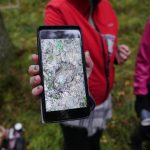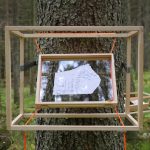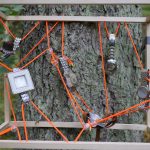The Nomad house program for Mad House Helsinki, curated by Tea Andreoletti & Daniela Pascual was organised trough an open call. Artists were invited rethink their practice by first imagining an audience they hoped to reach and then to develop performances for them. I wanted to meet all the habitants of the Degermossa road, which leads to the Kurängen spring deep in the Sipoonkorpi forest. I wanted to work with this group because I imagined they could offer me insight of the spring and the surrounding nature.
I visited most of the habitants of the road over the summer and interviewed them regarding their forest-relations. Invitations to this event where mailed last month and I delivered event brochures last weekend featuring a partial map. In the brochure I indicated that I’d meet with them at the end of the Degermossa road. People didn’t have to sign up in advance and I was very concerned whether any would come. It was ecstatic to see people arriving towards the meeting point walking the narrow road. Their participation felt like a gift. I offered people lunch, neatly packed in paper-bags and after a short introduction we hiked trough the forest.
The event was titled “The Forest Spring Affair” and I think I succeeded in the goals I set for it. Eventually 11 audience members came with me to the spring. The youngest audience members were 10 and the elders close to 80ties. The audience was chatting all thought the walk, they were curious and shared personal details on how they had moved to the Sipoonkorpi area and how their houses were connected to the surrounding nature. As a detail, one explained very exhaustively how water collects to their yard after rain, and forms a pool which is deep enough to swim in. An other told that their property had a spring, which in closer examination was revealed to be a well.
After a kilometre hike in a pretty but rough terrain we reached the spring… Which was dry. I’ve been visiting the spring frequently since 2019 and this was the first time it was void of water. There was no drinkable water in the pool. Viljami Lehtonen and I had visited the site the previous days, to transport our equipment to the site. Because the pool was dry, I took a bus to Tuulensuun lähteikkö in Vantaa and collected spring water from there. So, at Kurängen, I served the audience spring water collected the previous day from a different spring. This was a bizarre turn of events and people were humoured about it.
One artistic objective of the performance was to offer a ceramic vessel, made from the clay of the spring – Into the spring. I visited the spring early in the summer and tested the arrangement. As the earthenware ceramic jug (prepared during our Nomadic Kiln workshops) was submerged in the water it made a high pitch squealing sound. I wanted the audience to hear this sound which I presented to them as a “clay song”. When I poured water from Vantaa spring into the container… It did not make a sound! People were expecting a noise and as the vessel was silent, one noted: “It’s the wrong water”. I used the clay jug to serve people drinks, and after this I gave a short introduction of the exhibition and people walked around investigating the area.
Here is a recording from a previous session at the site:
I presented the audience displays of mineral water related equipment, rock samples, maps, watches (reference to different time-scales), videos and pottery made from the Kurängen spring clay. I also exhibited the fabric I removed from the spring basin last year as an wall rug and Viljami treated us with a wet-ambient concert.
People were really disappointed that there was no water in the spring but understood that drought was to blame (the wells on their backyards had dried out too). The drought might give them motivation to visit the site later on. The display worked well and I think that as people were not expecting to end up to an art event, they behaved in a relaxed manner. Viljami started the concert while people were discussing. They told each others stories about the forest, about encounters with wildlife and dogs. One member wanted to show to the group how they had handled a close encounter with two unleashed German shepherds. As there were kids in the audience they went on mimicking how the dogs barked, and presented their choreographic retreat – How they walked backwards away from the dogs territory, keeping eye contact with them, while making angry faces.
An other told of their encounter with a predator. While hiking they heard a deep breath behind them. The sound prompted them to immediately walk home, almost running trough a swamp. Reaching home they learned that a young bear had been sighted close by. An other had pictures of bear footprints to show. Some audience members investigated the felt material I put on display and concluded that the fabric was natural. I will have to test it further.
It was delightful. The event lasted for two hours, people ate their snacks and had fun.
As the event was not framed as a “performance” people took over and entertained themselves. I introduced Viljamis gig as a “concert” but the weird looking modular setup possibly did not look at all like a musical instrument and the audience didn’t understand what was producing the sounds (if Viljami had a violin people would have behaved differently, the modular-synth instrument does not have similar authoritative appeal!). They possibly assumed they were playing a recording and kept on interviewing Viljami as he was playing. Viljami handled this really well, chatting with the curious while performing. A modular synth system in a forest, manifested unexpected low-key punk-ish aesthetics. It brushed against expectations of what a concert is and helped in keeping the event horizontal.
This experience built up to a bizarre revelation: Because people were not expecting an artwork, they made the event theirs. But it can also be that the event reinforced existing behavioural modes. I’m not sure if people were far out, out or in of their comfort zone. I’m not sure where I was either. It was weirdfun for everyone involved.
The event was a logistical challenge and an art-infrastructural spectacle. We carried the six art displays, built to fit neatly in banana-cardboard boxes to the site. We also transported a pair of Genelec speakers, a power-station (720 Wh!) and a modular system (which hosted the Benjolin I built last year). All of the equipment could be transported on one go. The boxes could be carried using a custom shoulder mount. The kilometre hike trough the forest with speakers, batteries, art and what-nots was a roadie-delight. The demands overloaded us and we didn’t experience fatigue: The event beat my expectations in every scale.
Below is the initial introduction to the performance from the Mad House programme.
Finland does not have any wilderness and we are better off without yearning for it. What would “wilderness” be like? Every tree, branch and stone in a forest is owned and used by someone. A forest is a site of negotiation and the noises we hear in it are proposals. The traces forest creatures and bypassers leave behind define borders between habitats and species. Accessing, passing and working a forest requires that we confront others. The confrontations can be scary and life changing. If you are interested in engaging in swampy-forest-negotiations, I invite you to visit a spring located at the border of a natural reserve and the emerging city. I will primarily work with citizens living closest to the spring but if they accept, we will share details of these encounters with broader audiences. The events will be organised deep in the forest.













